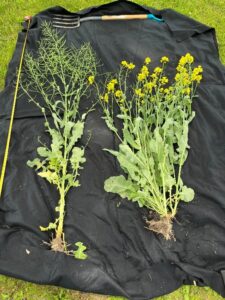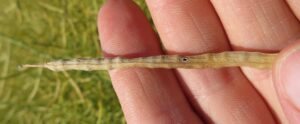In 2025, there were nearly 46,000 acres of canola insured by Agricorp. This includes winter canola seeded in 2024 and spring canola seeded in 2025. There were about 12% fewer acres compared to last season.
Spring Canola
Acres of spring canola in the Temiskaming District, where the greatest acreage of canola is grown in Ontario, declined from about 16,000 acres in 2024 to 12,000 acres in 2025. Acreage across the districts of Algoma, Cochrane, Manitoulin, Rainy River, Sudbury, Thunder Bay and Nipissing totalled about 12,000. Most seeding was completed in good time in May, while some fields were planted in June. Conditions were cool, and poor or slow emergence was noted on some fields.
Conditions were dry through spring and during seed fill in August. Flea beetle pressure warranted insecticide application in fields in Northwestern and Northeastern Ontario. Swede midge did not cause significant injury in the past few years, but damage was observed on a high percentage of fields this season. Damage was mostly observed on headlands and may have caused yield loss in some fields. Clubroot caused significant yield loss in fields last year, and again in 2025. Some fields are nearly a total loss because of clubroot, often on muck soils or loam soils with very low pH. A high percentage of fields in the Temiskaming District have clubroot, although yield loss can range from 0-90%. Agricorp have not reported average yields yet, but producers report that spring canola yields are average.
Winter Canola
Approximately 20,000 acres of seed were sold in 2024. Many producers pushed seeding earlier into August to establish large roots and crowns and improve winter survival. Warm weather lasted until the end of November, resulting in very large plants, especially where the canola was seeded on narrow (7.5”) row widths and where there was a lot of available nitrogen. Although plants did not bolt in the fall, large plants can develop a bit of a stem. When there are a lot of leaves on the rosette, the growing point is pushed up away from the soil surface. Plants like this are more susceptible to winter kill because the growing point is less protected, and large succulent plants can lose a significant amount of tissue through winter. Stand loss did occur in fields with excessive growth, and in many of these fields, the main growing point died, but the crown put out additional stems that were significantly delayed in maturity.

The winter was much colder than the past couple of years, and more winterkill was observed. Temperatures below -17 °C are detrimental to survival. It is unclear how much protection snow cover offered, as winter injury and winterkill were observed in many fields that had snow cover. Numerous fields were terminated because of extensive winterkill, and there were significant challenges in terminating large winter canola plants.
Fertilizer was applied at the appropriate timing in early spring. Through bolting and bloom conditions were cool, which is ideal for growth and avoiding flower abortion. Summer was very hot, but the high temperatures occurred after the bloom period. The crop was about 6’ tall in many fields, and in some, the plants were rubbing on the bottom of the sprayer when pre-harvest herbicide was applied.
There were widespread concerns about butterflies in winter canola fields, which also moved into neighbouring yards and other field crops. The butterflies, called cabbage whites, are white with a few black dots on their wings (Figure 2). They feed on the nectar of flowering plants, and the butterflies are not detrimental to canola or other crops. The larval stage of the cabbage white butterfly is a green, velvety caterpillar called a cabbage worm, and is 3cm long at maturity. They are a significant and frequent pest of locally produced Brassica vegetables, and the presence of their frass (feces) reduces the market value of Brassica vegetables. The larvae will feed on canola leaves and possibly on pods. The Western Canada and Ontario spring canola experience with these larvae would indicate it is not an economically significant pest. However, the increase in winter canola acreage in southern counties may have led to higher populations than observed in the past. While there were very high populations of butterflies, producers did not report finding larvae or significant defoliation. Canola can tolerate up to 50% defoliation in the vegetative stages. High levels of defoliation at the beginning of bloom may decrease yield and would be noticeable while scouting ahead of fungicide application. Leaf area becomes less important through flowering, when up to 70% of the leaves are shaded by flowers and pods. Producers were encouraged to monitor seedling canola for feeding this summer/fall, but insecticide seed treatments provide some protection.

As harvest approached and producers opened pods, some noticed holes in pods and damaged seeds inside, and caused by cabbage seedpod weevil larvae. Fields should be scouted for adult weevils ahead of fungicide applications, and insecticide can be applied along with fungicide if weevils are at threshold. Continue to monitor for weevils into the late bloom stages. Eggs are laid in young pods, which are present on the plants from about 10% bloom through to the end of flowering. The holes in the pods increase the risk of shatter loss.

Harvest was conducted through mid- to late-July. Yield results from an informal survey ranged from 42 to 86 bu/ac, with an average just below 70 bu/ac. About half of the respondents said their yield was average for their farm, and about half said it was below average, while a couple of producers said yield was above average. There were strong yields in both northern and southern regions. Issues reported through the survey included excessive growth in the fall, more winterkill than usual, and dry conditions during seed fill and harvest.
In 2025, approximately 20,000 acres of winter canola was seeded. Many producers reported poor stands in parts of fields, attributed to poor emergence due to a lack of rainfall or slug feeding.
